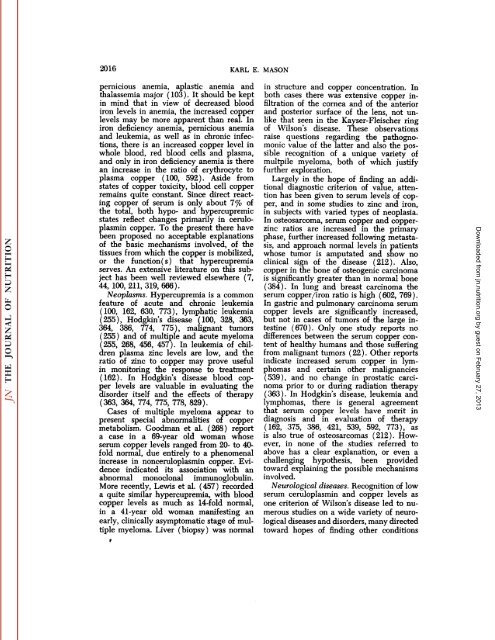conspectus of researchon copper metabolism and requirements
conspectus of researchon copper metabolism and requirements
conspectus of researchon copper metabolism and requirements
You also want an ePaper? Increase the reach of your titles
YUMPU automatically turns print PDFs into web optimized ePapers that Google loves.
2016 KARL E. MASON<br />
pernicious anemia, aplastic anemia <strong>and</strong><br />
thalassemia major ( 103). It should be kept<br />
in mind that in view <strong>of</strong> decreased blood<br />
iron levels in anemia, the increased <strong>copper</strong><br />
levels may be more apparent than real. In<br />
iron deficiency anemia, pernicious anemia<br />
<strong>and</strong> leukemia, as well as in chronic infec<br />
tions, there is an increased <strong>copper</strong> level in<br />
whole blood, red blood cells <strong>and</strong> plasma,<br />
<strong>and</strong> only in iron deficiency anemia is there<br />
an increase in the ratio <strong>of</strong> erythrocyte to<br />
plasma <strong>copper</strong> (100, 592). Aside from<br />
states <strong>of</strong> <strong>copper</strong> toxicity, blood cell <strong>copper</strong><br />
remains quite constant. Since direct react<br />
ing <strong>copper</strong> <strong>of</strong> serum is only about 1% <strong>of</strong><br />
the total, both hypo- <strong>and</strong> hypercupremic<br />
states reflect changes primarily in ceruloplasmin<br />
<strong>copper</strong>. To the present there have<br />
been proposed no acceptable explanations<br />
<strong>of</strong> the basic mechanisms involved, <strong>of</strong> the<br />
tissues from which the <strong>copper</strong> is mobilized,<br />
or the function(s) that hypercupremia<br />
serves. An extensive literature on this sub<br />
ject has been well reviewed elsewhere (7,<br />
44, 100, 211, 319, 666).<br />
Neoplasms. Hypercupremia is a common<br />
feature <strong>of</strong> acute <strong>and</strong> chronic leukemia<br />
(100, 162, 630, 773), lymphatic leukemia<br />
(255), Hodgkin's disease (100, 328, 363,<br />
364, 386, 774, 775), malignant tumors<br />
(255) <strong>and</strong> <strong>of</strong> multiple <strong>and</strong> acute myeloma<br />
(255, 268, 456, 457). In leukemia <strong>of</strong> chil<br />
dren plasma zinc levels are low, <strong>and</strong> the<br />
ratio <strong>of</strong> zinc to <strong>copper</strong> may prove useful<br />
in monitoring the response to treatment<br />
( 162 ). In Hodgkin's disease blood cop<br />
per levels are valuable in evaluating the<br />
disorder itself <strong>and</strong> the effects <strong>of</strong> therapy<br />
(363, 364, 774, 775, 778, 829).<br />
Cases <strong>of</strong> multiple myeloma appear to<br />
present special abnormalities <strong>of</strong> <strong>copper</strong><br />
<strong>metabolism</strong>. Goodman et al. (268) report<br />
a case in a 69-year old woman whose<br />
serum <strong>copper</strong> levels ranged from 20- to 40fold<br />
normal, due entirely to a phenomenal<br />
increase in nonceruloplasmin <strong>copper</strong>. Evi<br />
dence indicated its association with an<br />
abnormal monoclonal immunoglobulin.<br />
More recently, Lewis et al. (457 ) recorded<br />
a quite similar hypercupremia, with blood<br />
<strong>copper</strong> levels as much as 14-fold normal,<br />
in a 41-year old woman manifesting an<br />
early, clinically asymptomatic stage <strong>of</strong> mul<br />
tiple myeloma. Liver (biopsy) was normal<br />
in structure <strong>and</strong> <strong>copper</strong> concentration. In<br />
both cases there was extensive <strong>copper</strong> in<br />
filtration <strong>of</strong> the cornea <strong>and</strong> <strong>of</strong> the anterior<br />
<strong>and</strong> posterior surface <strong>of</strong> the lens, not un<br />
like that seen in the Kayser-Fleischer ring<br />
<strong>of</strong> Wilson's disease. These observations<br />
raise questions regarding the pathognomonic<br />
value <strong>of</strong> the latter <strong>and</strong> also the pos<br />
sible recognition <strong>of</strong> a unique variety <strong>of</strong><br />
multpile myeloma, both <strong>of</strong> which justify<br />
further exploration.<br />
Largely in the hope <strong>of</strong> finding an addi<br />
tional diagnostic criterion <strong>of</strong> value, atten<br />
tion has been given to serum levels <strong>of</strong> cop<br />
per, <strong>and</strong> in some studies to zinc <strong>and</strong> iron,<br />
in subjects with varied types <strong>of</strong> neoplasia.<br />
In osteosarcoma, serum <strong>copper</strong> <strong>and</strong> <strong>copper</strong>zinc<br />
ratios are increased in the primary<br />
phase, further increased following metasta<br />
sis, <strong>and</strong> approach normal levels in patients<br />
whose tumor is amputated <strong>and</strong> show no<br />
clinical sign <strong>of</strong> the disease (212). Also,<br />
<strong>copper</strong> in the bone <strong>of</strong> osteogenic carcinoma<br />
is significantly greater than in normal bone<br />
(384). In lung <strong>and</strong> breast carcinoma the<br />
serum <strong>copper</strong>/iron ratio is high (602, 769 ).<br />
In gastric <strong>and</strong> pulmonary carcinoma serum<br />
<strong>copper</strong> levels are significantly increased,<br />
but not in cases <strong>of</strong> tumors <strong>of</strong> the large in<br />
testine (670). Only one study reports no<br />
differences between the serum <strong>copper</strong> con<br />
tent <strong>of</strong> healthy humans <strong>and</strong> those suffering<br />
from malignant tumors (22 ). Other reports<br />
indicate increased serum <strong>copper</strong> in lymphomas<br />
<strong>and</strong> certain other malignancies<br />
(539), <strong>and</strong> no change in prostatic carci<br />
noma prior to or during radiation therapy<br />
(363). In Hodgkin's disease, leukemia <strong>and</strong><br />
lymphomas, there is general agreement<br />
that serum <strong>copper</strong> levels have merit in<br />
diagnosis <strong>and</strong> in evaluation <strong>of</strong> therapy<br />
(162, 375, 386, 421, 539, 592, 773), as<br />
is also true <strong>of</strong> osteosarcomas (212). How<br />
ever, in none <strong>of</strong> the studies referred to<br />
above has a clear explanation, or even a<br />
challenging hypothesis, been provided<br />
toward explaining the possible mechanisms<br />
involved.<br />
'Neurological diseases. Recognition <strong>of</strong> low<br />
serum ceruloplasmin <strong>and</strong> <strong>copper</strong> levels as<br />
one criterion <strong>of</strong> Wilson's disease led to nu<br />
merous studies on a wide variety <strong>of</strong> neuro<br />
logical diseases <strong>and</strong> disorders, many directed<br />
toward hopes <strong>of</strong> finding other conditions<br />
Downloaded from<br />
jn.nutrition.org<br />
by guest on February 27, 2013
















